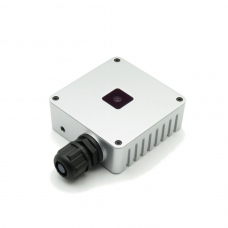OAK-1-PoE Auto Focus, OpenCV AI Machine Vision Kit, Depth Measuring, Image Recognition
Overview :
The OAK-1-PoE baseboard offers full 802.3af, Class 3 PoE compliance with 1000BASE-T speeds. The OAK-1-PoE (SJ2096POE) baseboard has one on-board cameras which implement RGB vision, piped directly into the OAK-SoM-Pro for depth and AI processing. The data is then output to a host via USB 3.1 Gen1 (Type-C) or via 1000BASE-T ethernet connection. The OAK-1-PoE board exposes boot selection switches, allowing the end user to boot the OAK-SoM-Pro module from USB or the on-board eMMC or NOR flash.
Hardware specifications
This OAK camera uses Power-over-Ethernet (PoE) for communication and power. It offers full 802.3af, Class 3 PoE compliance with 1000BASE-T speeds (1 Gbps) and has a micro SD (uSD) card connector. A PoE injector/switch is required to power the device.
|
Camera Specs |
Color camera |
|---|---|
|
Sensor |
|
|
DFOV / HFOV / VFOV |
81° / 69° / 55° |
|
Resolution |
12MP (4032x3040) |
|
Focus |
Auto-Focus: 8cm - ∞ |
|
Max Framerate |
60 FPS |
|
F-number |
2.0 |
|
Lens size |
1/2.3 inch |
|
Pixel size |
1.55µm x 1.55µm |
RVC2 inside :
This OAK device is built on top of the RVC2. Main features:
1. 4 TOPS of processing power (1.4 TOPS for AI)
2. Run any AI model, even custom architectured/built ones - models need to be converted.
3. Encoding: H.264, H.265, MJPEG - 4K/30FPS, 1080P/60FPS
4. Computer vision: warp/dewarp, resize, crop via ImageManip node, edge detection, feature tracking. You can also run custom CV functions
5. Stereo depth perception with filtering, post-processing, RGB-depth alignment, and high configurability
6. Object tracking: 2D and 3D tracking with ObjectTracker node
Dimensions and Weight :
Width: 82 mm
Height: 114 mm
Length: 32 mm
Weight: 294g
Board Layout


Power usage :
Power usage for OAK-1-PoE ranges between 1.94 W (standby) and 4.56 W (max consumption). More information on the power usage is below:
-
Standby: 1.94 W
-
Normal operation (running
python depthai_demo.py): 4.20 W -
Max consumption power (running
python depthai_demo.py -s left right color disparity rectified_left depth): 4.56 W

Getting started :
Note :
For more information on how to start with POE devices, check our guide Getting started with OAK PoE devices.
This OAK PoE camera accepts power input from he 802.3af, Class 3 PoE circuitry. It can also accect power through the on-board USB C connector - which is not expsed through the enclsoure, so enclosure needs to be removed.
Booting can be accomplished from either the USB interface or from the eMMC or NOR flash on the OAK-SoM-Pro, and boot selection is configured with the DIP switch bank near the USB connector.
Interfacing with the OAK-SoM-Pro is also possible with PoE Board connector pads J5 and J8, which expose OAK-SoM-Pro auxiliary I/O and BW2099 Quad SPI, respectively. These headers are Amphenol/FCI 20021121-00010T1LF or equivalent. Please refer to the schematics for pinout information.
-
The reset button resets the OAK-SoM-Pro only.
-
The 5V LED indicates 5V power is present on the BW2098POE.
-
The PG LED indicates “power good” from the OAK-SoM-Pro.
-
The “RUN” LED indicates that the OAK-SoM-Pro is not in reset.
Caution should be taken when handling any PoE circuit board. Do not directly touch the circuitry as potentials up to and exceeding 57V may exist. Always use electronics handling best practices.
Documents Related to OAK-1-PoE Auto Focus : Datasheet
Enter the code in the box below:


